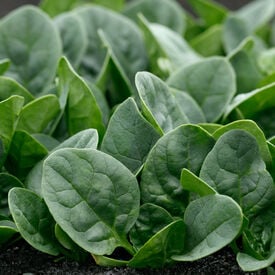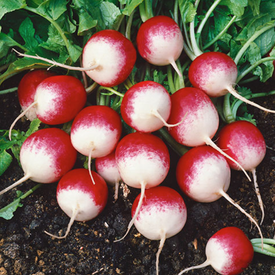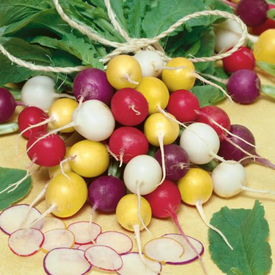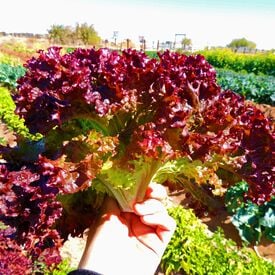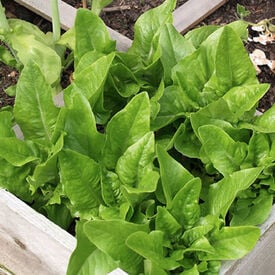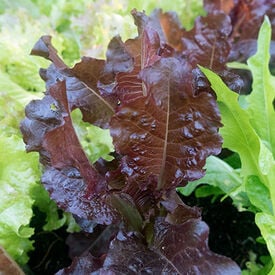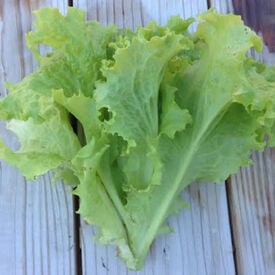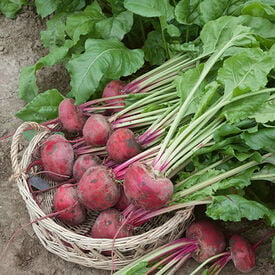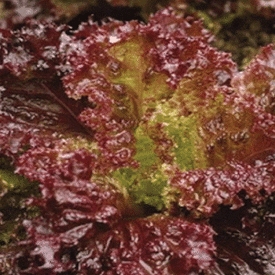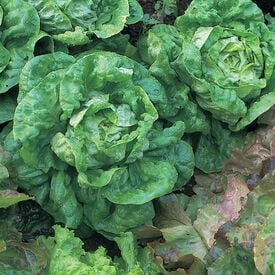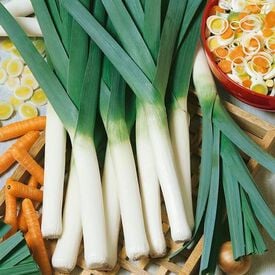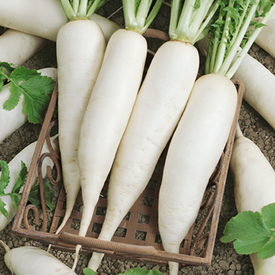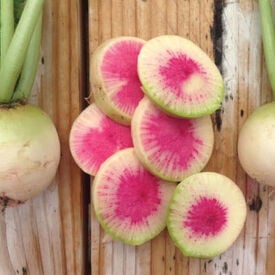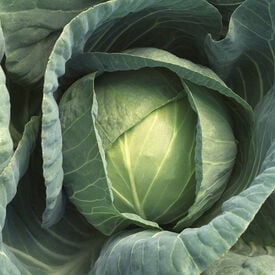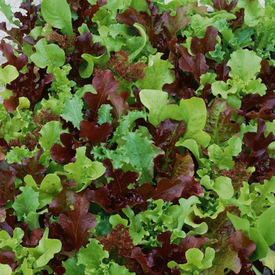Countryside is a beautiful dark green very uniform baby leaf spinach variety. It has thick smooth round oval leaves. Countryside has good holding ability for baby leaf and it has acceptable bolt tolerance for fresh market growers. Due to its moderate growth habit, it has performed well in many West Coast baby leaf growing slots.
The Sparkler Radish is a bright scarlet colored radish with a sweet, juicy flesh and snappy flavor. This variety's scarlet skin fades to white on lower 1/3 of its round, to round oval bulb. This radish's medium tops are perfect for both home and market gardens. Sparkler can grow up to 1.5" diameter.
The Crayon Colors Mix is a mixture of primary colored radishes that literally paints a wonderful colorful palette in your garden! The color in this mix includes yellow, pink, red, and purple.
The Selway is a Lolla Rossa type lettuce with beautiful light green and dark purple coloring. This variety has deeply curled loose leaves with frilled dark-purple edges edges. The Selway is an essential in salad mixes for its color and taste. For baby leaf production, this variety can be harvested in 30 days and for full sized leaves, it can be harvested in 55 days and can be cut repeatedly!
The Deer Tongue Lettuce really does look like a deer tongue! These triangular leaves are excellent for baby salad greens. Deer Tongue lettuce has medium-green leaves that form loose upright heads that are slow to bolt. This is a popular variety with many heirloom growers, as Deer Tongue has been an Amish favorite for decades!
The Sunset is a beautiful deep red looseleaf lettuce that is slow to bolt. The very attractive crinkled leaves make it a favorite in any salad or dish. This lettuce was an AAS winner in 1987, and since has been known to be a rare lettuce leaf. The delicious Sunset lettuce is a great variety for home and market growers alike. Certified Organic. Learn more about our organic seeds.
The Romanesco broccoli is a funky little vibrant broccoli! Known for its different appearance, it is also a really great tasting broccoli! This Italian variety is bright lime green with lots of texture. The Romanesco is excellent for cool areas.
The Purple Italian Globe Artichoke, scientifically known as Cynara scolymus var. scolymus, is a stunning and delectable vegetable that has a rich history dating back to ancient times. Originating in the Mediterranean region, this particular variety of artichoke has been cultivated for centuries and is prized for both its ornamental appearance and culinary value. Its striking purple and green hues make it a unique addition to any garden or dinner table. In terms of taste, the Purple Italian Globe Artichoke boasts a mild, nutty flavor with a slightly sweet and earthy undertone. The tender inner leaves and heart are the most sought-after parts and are often used in various dishes, from salads and dips to braised or roasted preparations. The artichoke can grow to a substantial size, typically reaching diameters of 4 to 6 inches, making it a substantial vegetable for cooking. The Purple Italian Globe Artichoke is known for its longer days to maturity, typically requiring around 150 to 180 days from planting to harvest. Each plant typically yields multiple artichokes, and they can be propagated from seeds or offsets. These plants thrive in well-drained, nutrient-rich soil and prefer full sun exposure. Adequate spacing and regular watering are essential for optimal growth. Overall, this variety of artichoke offers not only a delicious addition to your culinary endeavors but also a visually striking and historical component to your garden.
The Seafresh Lettuce was selected for its great heat tolerance! This variety is a great tasting looseleaf lettuce that thrives in hotter climates. The Seafresh Lettuce is a great addition to any garden and will definitely not be a disappointment!
Lutz Green Leaf Pink Stem beet seeds are prized for producing beets with distinctive characteristics and exceptional flavor. This variety features vibrant green leaves with a striking pink stem, which adds a splash of color to any garden. The beets themselves are known for their smooth, round shape and tender, sweet, deep red to purple flesh. Lutz Green Leaf Pink Stem beets are valued not only for their aesthetic appeal but also for their excellent taste, making them a popular choice for salads, roasting, and pickling. They are known for their adaptability, growing well in various soil conditions, and for their relatively long harvest window, allowing for a prolonged period of fresh, nutritious beets. Additionally, the green leaves are edible and nutritious, providing a dual-purpose crop that enhances both the visual and culinary appeal of your garden. This variety is a "winterkeeper" beet that has a long standing storage capability. The Lutz Green Leaf Pink Stem has 6 inches in diameter roots, make sure to thin them out to 4-6 inches.
The Crosby Egyptian Beet, a classic heirloom variety, has a rich history dating back to the late 19th century. Originating in Egypt, it was introduced to the United States in the 1860s and quickly gained popularity among gardeners and farmers. This beet variety has stood the test of time due to its exceptional taste and versatility in the kitchen. Crosby Egyptian Beets are known for their sweet and tender flesh, making them a favorite for both raw and cooked applications. They have a distinct earthy flavor with a hint of sweetness, making them perfect for salads, pickling, roasting, and even juicing. These beets typically mature in about 55-60 days, making them a relatively quick-growing option for gardeners. In terms of appearance, Crosby Egyptian Beets are small to medium-sized, usually reaching about 2-3 inches in diameter. They have a round to slightly flattened shape and a vibrant deep red or purplish skin. Disease resistance is moderate, with some resistance to common pests and diseases like aphids and leaf miners. In terms of yields, you can expect a good harvest of beets from each plant, especially if you space them adequately (about 2-4 inches apart) in well-drained soil with full sun to partial shade. These beets thrive in cool weather conditions, making them suitable for spring and fall planting. With its rich history and delightful flavor, the Crosby Egyptian Beet continues to be a treasured addition to vegetable gardens.
Lolla Rossa lettuce is a beautiful Italian heirloom variety originating from the Lolla region near Bergamo, known for its striking deep-red, frilly leaves and crisp texture. Typically forming compact, loose-leaf rosettes about 6 to 8 inches across, it adds vibrant color and visual appeal to salads and garden beds alike. The leaves are tender yet slightly crunchy, offering a mild, slightly bitter flavor with a subtle nutty finish. Lolla Rossa thrives in cool weather and prefers full sun with well-drained, fertile soil rich in organic matter. It grows best in temperatures between 45–70°F and benefits from consistent moisture, making it ideal for spring and fall planting.
All The Year Round Lettuce is a medium-sized green headed lettuce that is just like its name, good for all the year round! This slow bolt variety is solid even in hot weather, and good for far northern areas as it is very hardy. Sow All The Year Round in spring or late summer!
The hardy American Flag leek is a good variety for both home and market growers. The attractive uniform leek has blue green leaves and white stalks. The American Flag variety has a very nice sweet flavor. This leek can be enjoyed during fall and winter. Certified Organic. Learn more about our organic seeds.
Daikon Radish has a crisp firm flesh is pure white. This Daikon radish, produces long tapered white radishes that are mostly used as winter radishes. The Minowase has a great, mild taste that is excellent in many Oriental dishes. This radish variety is great for spring or late summer planting.
Watermelon radish is a striking and flavorful root vegetable that adds both color and variety to the garden. Known for its vibrant pink to red interior, which contrasts with its pale greenish-white skin, this radish variety is a favorite among gardeners looking for something unique. Watermelon radishes are cool-season crops, thriving in the early spring or fall when temperatures are mild. They prefer well-drained, loose soil and require consistent moisture to grow to their full potential. The plants develop large, round roots that can reach up to 4 inches in diameter, and their slightly peppery flavor becomes milder and sweeter when grown to full maturity. Watermelon radishes grow best when spaced 2-3 inches apart to allow room for their large roots. They are relatively easy to grow, with a quick turnaround from planting to harvest—usually around 50 to 70 days. Besides their stunning appearance, watermelon radishes are versatile in the kitchen, perfect for salads, pickling, or as a crunchy garnish. Their unique beauty and crisp, mildly spicy flavor make them a showstopper in any home garden.
Bobcat is a high producing fresh-market variety that has long storage life. Excellent flavor and good resistance to disease. Due to its high yield potential, Bobcat is suitable for coleslaw production.
The Mini Greens Blend is a colorful mixture of red and green leaf lettuce varieties that creates a wonderful bright combination. This blend is neither considered a sprout nor true baby leaf lettuce either, these delicious mini greens are somewhere in between! The Mini Greens Blend will give you greens in just 2 weeks from germination to harvest!
